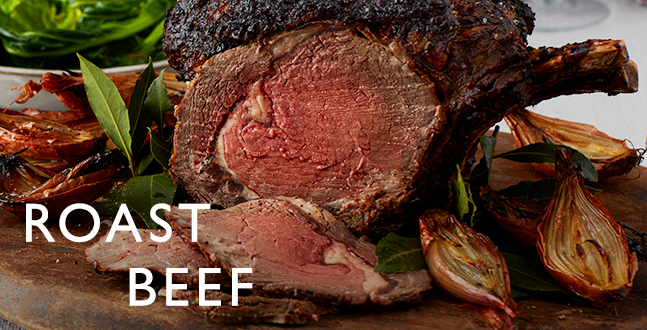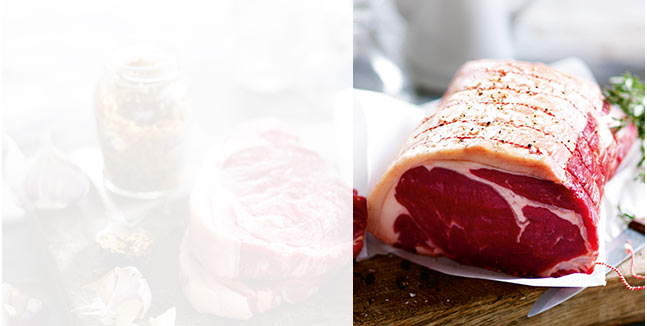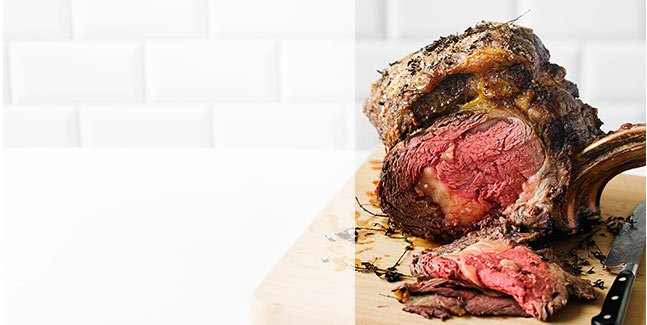Roast beef
The centrepiece to a quintessential British Sunday lunch, flavoursome roast beef deserves the spotlight
Whether you like it rare, medium or well done, tender juicy slices of beef with all the trimmings are hard to beat. Here are our top tips on how to achieve the perfect roast beef.
1) Choose the right cut
The go-to joint for a succulent beef roast is a wing rib of beef, which has an eye of tender, marbled meat. Taken from the back of the loin, it can also be cooked off the bone by rolling it into a sirloin joint.
Fore rib is a great alternative – taken from further up the loin, it has a seam of fat running through it, giving it lots of flavour.

For a leaner roast, topside is an excellent choice and for a slightly fattier cut, top rump is also a good option. Both are best served rare/medium rare and are delicious served cold in sandwiches and salads.
2) Size matters
Try to buy a joint slightly larger than you actually need, as smaller joints tend to shrink a little in the oven; use any leftovers for delicious midweek meals.
As a general rule, when you’re buying a joint of meat on the bone you’ll need to allow approximately 400g meat per person. So to feed 6 people you’ll need a joint that weighs around 2.5kg, which will usually be a 2 or 3 rib joint. For lean joints off the bone, allow 200 - 250g meat per person, so choose a joint around 2kg for 6 people.
4) Get cooking
Calculate the cooking time according to the guide below, with the meat positioned in the centre of the oven. Choose a roasting tin that’s a little larger than the joint – not too large or your precious gravy juices will evaporate. Add a peeled and halved onion and few sprigs of herbs such as thyme or rosemary while your beef cooks. This will caramelise the onions and add more flavour to your gravy.
Preheat your oven to the correct temperature to ensure your cooking time is accurate: 220C/Gas 7/fan 200C. Cook larger roasting joints on a high heat for the first 20 minutes to let the heat really penetrate the meat and give it a good crust on the outside. Remember to reduce the temperature after 20 minutes and deduct the 20 minutes from the total cooking time - leave the oven door open for a couple of minutes to help it cool down. There’s no need to cover your beef while it cooks; you want to get a good crust on the outside and foil won’t help with this.

Medium rare – 20 minutes per 500g
Medium – 25 minutes per 500g
Well done – 30 minutes per 500g

5) Baste your meat
Basting simply means spooning the juices from the roasting tin back over the meat while it cooks. Take the roasting tin out of the oven and tilt the tin slightly so that the fat and juices collect in one corner. Use a spoon or turkey baster to scoop them up and drizzle them over the meat. Baste the beef 2 or 3 times while it’s cooking and remember to shut the oven door while you do this, so you don’t lose heat.
6) Check your meat is cooked properly
Rare, medium or well done? Our guide to cooking times will help you cook the beef to your liking. Check your beef is cooked by piercing the thickest part of the joint with a skewer - if the juices are pinky-red, the meat will be medium-rare, slightly pink and it’s medium, and if you want it well done, they should run clear. A meat thermometer is useful for large joints. Push the probe into the meat as close as possible to the centre (avoiding any bones) and leave it for 20 seconds before taking the reading. Rare beef should read 50C, medium 60C and well done 70C.






